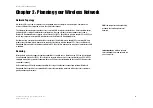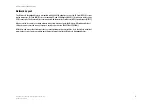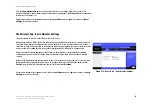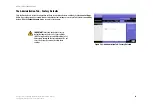
15
Chapter 5: Configuring the Wireless-B Broadband Router
The Setup Tab - Advanced Routing
Wireless-B Broadband Router
The Setup Tab - Advanced Routing
This tab is used to set up the Router’s advanced functions. Dynamic Routing will automatically adjust how packets
travel on your network. Static Routing sets up a fixed route to another network destination. (See Figure 5-11.)
NAT. Network Address Translation (NAT) technology translates IP addresses of a local area network to a different
IP address for the Internet. To enable the NAT function, click
Enable
.
Dynamic Routing. With Dynamic Routing you can enable the Gateway to automatically adjust to physical
changes in the network’s layout. The Gateway, using the RIP protocol, determines the network packets’ route
based on the fewest number of hops between the source and the destination. The RIP protocol regularly
broadcasts routing information to other Gateways on the network. To enable RIP, click
Enabled
. To disable RIP,
click
Disabled
.
•
Transmit RIP Version. To transmit RIP messages, select the protocol you want:
RIP1, RIP1-Compatible, or
RIP2
. If you don’t want to transmit RIP messages, select
None
.
•
Receive RIP Version. To receive RIP messages, select the protocol you want:
RIP1
or
RIP2
. If you don’t want
to receive RIP messages, select
None
.
Static Routing. To set up a static route between the Router and another network, select a number from the Select
Entry drop-down list. (A static route is a pre-determined pathway that network information must travel to reach a
specific host or network.) Enter the information described below to set up a new static route. (Clicking the
Delete
Entry
will delete a static route.)
Destination IP Address. The Destination LAN IP is the address of the remote network or host to which you want
to assign a static route.
Subnet Mask. The Subnet Mask determines which portion of a Destination LAN IP address is the network
portion, and which portion is the host portion.
Gateway. This is the IP address of the gateway device that allows for contact between the Router and the
remote network or host.
Hop Count. This determines the maximum number of steps between network nodes that data packets will
travel. A node is any router in the path to the remote network.
Interface. This interface tells you whether the Destination IP Address is on the
Local
(Ethernet and wireless
networks) or the
Internet
.
Figure 5-11: Setup Tab - Advanced Routing
Figure 5-12: Setup Tab - Routing Table






























